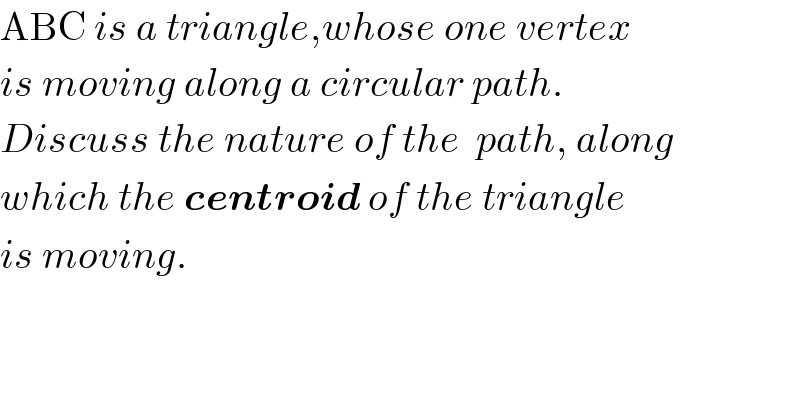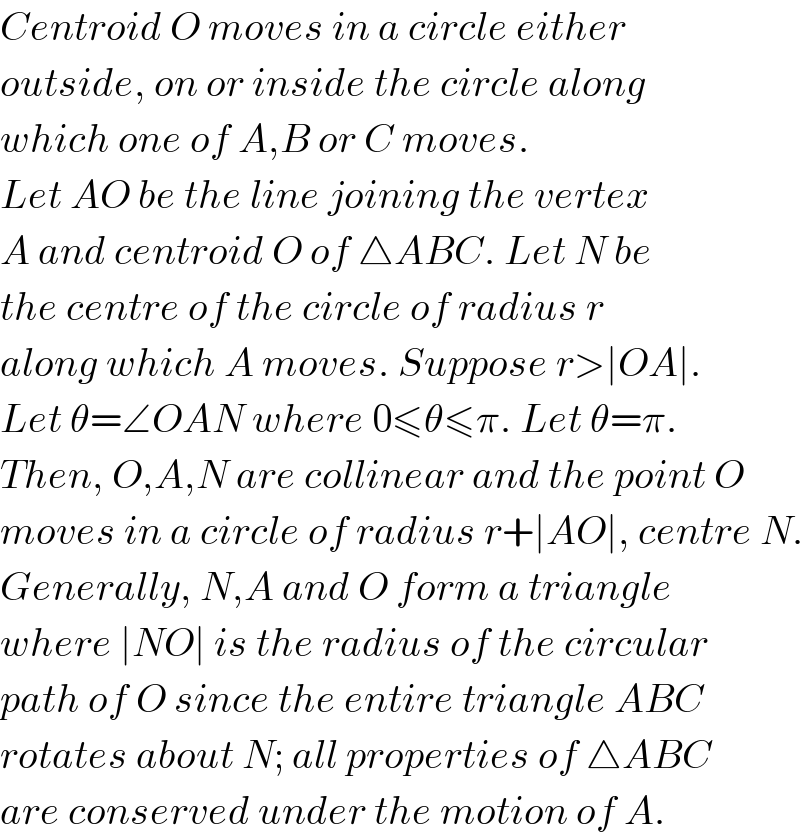
Question Number 6640 by Rasheed Soomro last updated on 07/Jul/16

$$\mathrm{ABC}\:{is}\:{a}\:{triangle},{whose}\:{one}\:{vertex}\: \\ $$$${is}\:{moving}\:{along}\:{a}\:{circular}\:{path}.\: \\ $$$${Discuss}\:{the}\:{nature}\:{of}\:{the}\:\:{path},\:{along} \\ $$$${which}\:{the}\:\boldsymbol{{centroid}}\:{of}\:{the}\:{triangle} \\ $$$${is}\:{moving}. \\ $$
Commented by Rasheed Soomro last updated on 08/Jul/16

$${If}\:\:\mathrm{A}\:\:{in}\:{a}\:\bigtriangleup\mathrm{ABC}\:\:{is}\:{a}\:{moving}\:{point},\:{then}\: \\ $$$$\overline {\mathrm{BC}}\:\:{and}\:{objects}\:{tied}\:{with}\:{it}\:{will}\:{be}\:\boldsymbol{{static}}. \\ $$
Commented by Yozzii last updated on 07/Jul/16

$${Centroid}\:{O}\:{moves}\:{in}\:{a}\:{circle}\:{either}\: \\ $$$${outside},\:{on}\:{or}\:{inside}\:{the}\:{circle}\:{along} \\ $$$${which}\:{one}\:{of}\:{A},{B}\:{or}\:{C}\:{moves}. \\ $$$${Let}\:{AO}\:{be}\:{the}\:{line}\:{joining}\:{the}\:{vertex} \\ $$$${A}\:{and}\:{centroid}\:{O}\:{of}\:\bigtriangleup{ABC}.\:{Let}\:{N}\:{be} \\ $$$${the}\:{centre}\:{of}\:{the}\:{circle}\:{of}\:{radius}\:{r} \\ $$$${along}\:{which}\:{A}\:{moves}.\:{Suppose}\:{r}>\mid{OA}\mid. \\ $$$${Let}\:\theta=\angle{OAN}\:{where}\:\mathrm{0}\leqslant\theta\leqslant\pi.\:{Let}\:\theta=\pi. \\ $$$${Then},\:{O},{A},{N}\:{are}\:{collinear}\:{and}\:{the}\:{point}\:{O} \\ $$$${moves}\:{in}\:{a}\:{circle}\:{of}\:{radius}\:{r}+\mid{AO}\mid,\:{centre}\:{N}. \\ $$$${Generally},\:{N},{A}\:{and}\:{O}\:{form}\:{a}\:{triangle} \\ $$$${where}\:\mid{NO}\mid\:{is}\:{the}\:{radius}\:{of}\:{the}\:{circular} \\ $$$${path}\:{of}\:{O}\:{since}\:{the}\:{entire}\:{triangle}\:{ABC} \\ $$$${rotates}\:{about}\:{N};\:{all}\:{properties}\:{of}\:\bigtriangleup{ABC} \\ $$$${are}\:{conserved}\:{under}\:{the}\:{motion}\:{of}\:{A}.\: \\ $$
Commented by Yozzii last updated on 07/Jul/16
![So, ∣NO∣=(√(r^2 +∣AO∣^2 −2r∣AO∣cosθ)). If O lies on the circle just as A moves along it, ∣NO∣=r ⇒cosθ=((∣AO∣)/(2r)). θ=cos^(−1) ((∣AO∣)/(2r)) Since ∣cosθ∣≤1 ∀θ∈[0,π], ⇒∣AO∣≤2r or r≥(1/2)∣AO∣ So, if the triangle is to be positioned so that both A and the centroid O move on the same circle of radius r it is necessary that r≥0.5∣AO∣ and θ=cos^(−1) ((∣AO∣)/(2r)). If θ=0⇒∣NO∣=r−∣OA∣ so O moves along a circle inside the circle for A.](Q6645.png)
$${So},\:\mid{NO}\mid=\sqrt{{r}^{\mathrm{2}} +\mid{AO}\mid^{\mathrm{2}} −\mathrm{2}{r}\mid{AO}\mid{cos}\theta}. \\ $$$${If}\:{O}\:{lies}\:{on}\:{the}\:{circle}\:{just}\:{as}\:{A}\:{moves}\: \\ $$$${along}\:{it},\:\mid{NO}\mid={r}\:\Rightarrow{cos}\theta=\frac{\mid{AO}\mid}{\mathrm{2}{r}}.\: \\ $$$$\theta={cos}^{−\mathrm{1}} \frac{\mid{AO}\mid}{\mathrm{2}{r}} \\ $$$${Since}\:\mid{cos}\theta\mid\leqslant\mathrm{1}\:\forall\theta\in\left[\mathrm{0},\pi\right],\:\Rightarrow\mid{AO}\mid\leqslant\mathrm{2}{r}\:{or}\:{r}\geqslant\frac{\mathrm{1}}{\mathrm{2}}\mid{AO}\mid \\ $$$${So},\:{if}\:{the}\:{triangle}\:{is}\:{to}\:{be}\:{positioned} \\ $$$${so}\:{that}\:{both}\:{A}\:{and}\:{the}\:{centroid}\:{O}\:{move} \\ $$$${on}\:{the}\:{same}\:{circle}\:{of}\:{radius}\:{r}\:{it}\:{is}\:{necessary}\:{that} \\ $$$${r}\geqslant\mathrm{0}.\mathrm{5}\mid{AO}\mid\:{and}\:\theta={cos}^{−\mathrm{1}} \frac{\mid{AO}\mid}{\mathrm{2}{r}}. \\ $$$${If}\:\theta=\mathrm{0}\Rightarrow\mid{NO}\mid={r}−\mid{OA}\mid\:{so}\:{O}\:{moves} \\ $$$${along}\:{a}\:{circle}\:{inside}\:{the}\:{circle}\:{for}\:{A}. \\ $$
Commented by Rasheed Soomro last updated on 08/Jul/16

$${Nice}! \\ $$$${Actually},\:{I}\:{think},\:\:{every}\:{point}\:\boldsymbol{{tied}}\:\boldsymbol{{with}}\:\boldsymbol{{triangle}}, \\ $$$$\left({which}\:{is}\:\:{not}\:{on}\:{the}\:{opposite}\:{side}\:{of}\:{moving}\:{vertex}\right) \\ $$$${is}\:\:{moving}\:{in}\:{circular}\:{path}\left({whether}\:{the}\:{points}\right. \\ $$$${are}\:{on}\:{the}\:{triangle}\:{or}\:{inside}\:{the}\:{triangle}\:{or} \\ $$$${outside}\:{the}\:{triangle}. \\ $$
